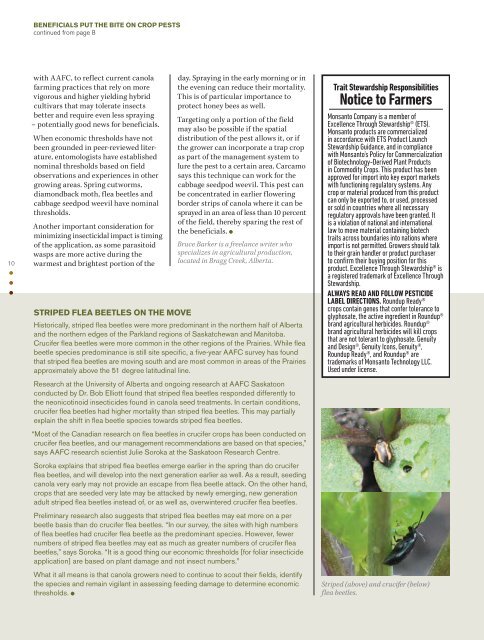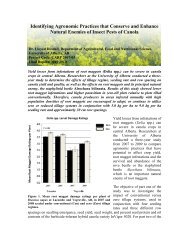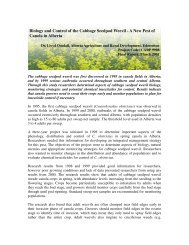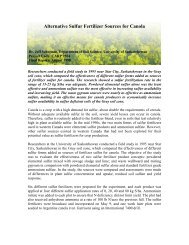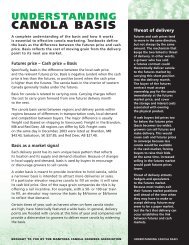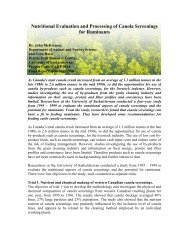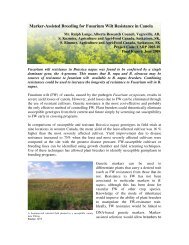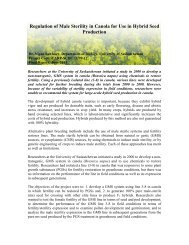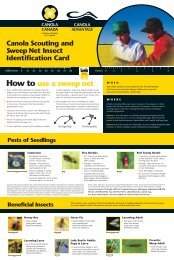Canola Digest, January 2013 - SaskCanola
Canola Digest, January 2013 - SaskCanola
Canola Digest, January 2013 - SaskCanola
Create successful ePaper yourself
Turn your PDF publications into a flip-book with our unique Google optimized e-Paper software.
BENEFICIALS PUT THE BITE ON CROP PESTS<br />
continued from page 8<br />
10<br />
with AAFC, to reflect current canola<br />
farming practices that rely on more<br />
vigorous and higher yielding hybrid<br />
cultivars that may tolerate insects<br />
better and require even less spraying<br />
– potentially good news for beneficials.<br />
When economic thresholds have not<br />
been grounded in peer-reviewed literature,<br />
entomologists have established<br />
nominal thresholds based on field<br />
observations and experiences in other<br />
growing areas. Spring cutworms,<br />
diamondback moth, flea beetles and<br />
cabbage seedpod weevil have nominal<br />
thresholds.<br />
Another important consideration for<br />
minimizing insecticidal impact is timing<br />
of the application, as some parasitoid<br />
wasps are more active during the<br />
warmest and brightest portion of the<br />
STRIPED FLEA BEETLES ON THE MOVE<br />
day. Spraying in the early morning or in<br />
the evening can reduce their mortality.<br />
This is of particular importance to<br />
protect honey bees as well.<br />
Targeting only a portion of the field<br />
may also be possible if the spatial<br />
distribution of the pest allows it, or if<br />
the grower can incorporate a trap crop<br />
as part of the management system to<br />
lure the pest to a certain area. Carcamo<br />
says this technique can work for the<br />
cabbage seedpod weevil. This pest can<br />
be concentrated in earlier flowering<br />
border strips of canola where it can be<br />
sprayed in an area of less than 10 percent<br />
of the field, thereby sparing the rest of<br />
the beneficials. •<br />
Bruce Barker is a freelance writer who<br />
specializes in agricultural production,<br />
located in Bragg Creek, Alberta.<br />
Historically, striped flea beetles were more predominant in the northern half of Alberta<br />
and the northern edges of the Parkland regions of Saskatchewan and Manitoba.<br />
Crucifer flea beetles were more common in the other regions of the Prairies. While flea<br />
beetle species predominance is still site specific, a five-year AAFC survey has found<br />
that striped flea beetles are moving south and are most common in areas of the Prairies<br />
approximately above the 51 degree latitudinal line.<br />
Research at the University of Alberta and ongoing research at AAFC Saskatoon<br />
conducted by Dr. Bob Elliott found that striped flea beetles responded differently to<br />
the neonicotinoid insecticides found in canola seed treatments. In certain conditions,<br />
crucifer flea beetles had higher mortality than striped flea beetles. This may partially<br />
explain the shift in flea beetle species towards striped flea beetles.<br />
“Most of the Canadian research on flea beetles in crucifer crops has been conducted on<br />
crucifer flea beetles, and our management recommendations are based on that species,”<br />
says AAFC research scientist Julie Soroka at the Saskatoon Research Centre.<br />
Soroka explains that striped flea beetles emerge earlier in the spring than do crucifer<br />
flea beetles, and will develop into the next generation earlier as well. As a result, seeding<br />
canola very early may not provide an escape from flea beetle attack. On the other hand,<br />
crops that are seeded very late may be attacked by newly emerging, new generation<br />
adult striped flea beetles instead of, or as well as, overwintered crucifer flea beetles.<br />
Preliminary research also suggests that striped flea beetles may eat more on a per<br />
beetle basis than do crucifer flea beetles. “In our survey, the sites with high numbers<br />
of flea beetles had crucifer flea beetle as the predominant species. However, fewer<br />
numbers of striped flea beetles may eat as much as greater numbers of crucifer flea<br />
beetles,” says Soroka. “It is a good thing our economic thresholds [for foliar insecticide<br />
application] are based on plant damage and not insect numbers.”<br />
What it all means is that canola growers need to continue to scout their fields, identify<br />
the species and remain vigilant in assessing feeding damage to determine economic<br />
thresholds. •<br />
Trait Stewardship Responsibilities<br />
Notice to Farmers<br />
Monsanto Company is a member of<br />
Excellence Through Stewardship® (ETS).<br />
Monsanto products are commercialized<br />
in accordance with ETS Product Launch<br />
Stewardship Guidance, and in compliance<br />
with Monsanto’s Policy for Commercialization<br />
of Biotechnology-Derived Plant Products<br />
in Commodity Crops. This product has been<br />
approved for import into key export markets<br />
with functioning regulatory systems. Any<br />
crop or material produced from this product<br />
can only be exported to, or used, processed<br />
or sold in countries where all necessary<br />
regulatory approvals have been granted. It<br />
is a violation of national and international<br />
law to move material containing biotech<br />
traits across boundaries into nations where<br />
import is not permitted. Growers should talk<br />
to their grain handler or product purchaser<br />
to confirm their buying position for this<br />
product. Excellence Through Stewardship® is<br />
a registered trademark of Excellence Through<br />
Stewardship.<br />
ALWAYS READ AND FOLLOW PESTICIDE<br />
LABEL DIRECTIONS. Roundup Ready®<br />
crops contain genes that confer tolerance to<br />
glyphosate, the active ingredient in Roundup®<br />
brand agricultural herbicides. Roundup®<br />
brand agricultural herbicides will kill crops<br />
that are not tolerant to glyphosate. Genuity<br />
and Design®, Genuity Icons, Genuity®,<br />
Roundup Ready®, and Roundup® are<br />
trademarks of Monsanto Technology LLC.<br />
Used under license.<br />
Striped (above) and crucifer (below)<br />
flea beetles.


